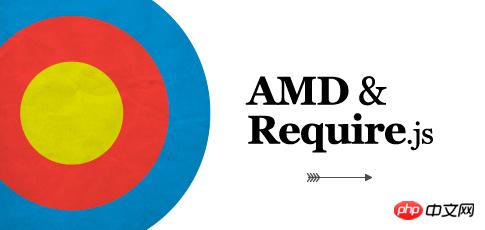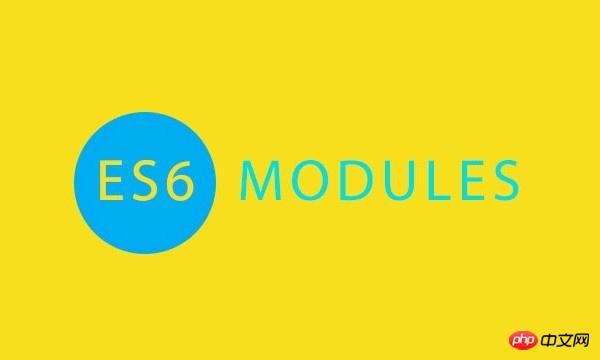Detailed explanation of require, import and export in JavaScript
This article will give you a detailed explanation of require, import and export in JavaScript. It has certain reference value. Friends in need can refer to it. I hope it will be helpful to you.
Why is there a module concept?
Ideally, developers only need to implement the core business logic, and other things can be loaded that have been written by others. module.
However, Javascript is not a modular programming language. Before es6, it did not support "class", so there was no "module".
require era
The Javascript community has made a lot of efforts to achieve the effect of "module" in the existing operating environment.
Original writing
A module is a set of methods that implement specific functions.
As long as different functions (and variables that record status) are simply put together, it is considered a module.
function m1(){
//...
}
function m2(){
//...
}The disadvantages of this approach are obvious: it "pollutes" global variables, there is no guarantee that variable names will not conflict with other modules, and there is no direct relationship between module members. The above functions m1() and m2() form a module. When using it, just call it directly.
Object writing method
In order to solve the above shortcomings, the module can be written as an object, and all module members are placed in this object
var module1 = new Object({
_count : 0,
m1 : function (){
//...
},
m2 : function (){
//...
}
});The above functions m1() and m2() are encapsulated in the module1 object. When used, just call the properties of this object
module1.m1();
This way of writing will expose all module members, and the internal state can be rewritten externally. For example, external code can directly change the value of an internal counter.
module._count = 1;
Using "Immediately-Invoked Function Expression" (IIFE) can achieve the purpose of executing the function immediately without exposing private members.
var module = (function() {
var _count = 0;
var m1 = function() {
alert(_count)
}
var m2 = function() {
alert(_count + 1)
}
return {
m1: m1,
m2: m2
}
})()Use the above writing method, External code cannot read the internal _count variable.
console.info(module._count); //undefined
module is the basic way of writing Javascript modules.
Mainstream module specifications
Before es6, there was no set of official specifications proposed, which depends on the degree of community and framework promotion. In other words, there are currently two popular JavaScript module specifications: CommonJS and AMD
CommonJS specification

var math = require('math'); var math = require('math');
math.add(2,3); // 5AMD specification
 ##After having the server-side module, it is natural that everyone Just want the client module. And it is best if the two are compatible, so that a module can run on both the server and the browser without modification.
##After having the server-side module, it is natural that everyone Just want the client module. And it is best if the two are compatible, so that a module can run on both the server and the browser without modification.
However, due to a major limitation, the CommonJS specification is not suitable for browser environments. Still the code in the previous section, if run in the browser, there will be a big problem
var math = require('math');
math.add(2, 3);The second line math.add(2, 3), the first line require('math') Then run, so you must wait for math.js to finish loading. That is, if it takes a long time to load, the entire app just hangs there waiting.
This is not a problem on the server side, because all modules are stored in the local hard disk and can be loaded synchronously. The waiting time is the reading time of the hard disk. However, for browsers, this is a big problem, because the modules are placed on the server side, and the waiting time depends on the speed of the network. It may take a long time, and the browser is in a "suspended death" state.
Therefore, browser-side modules cannot use "synchronous loading" (synchronous), but can only use "asynchronous loading" (asynchronous). This is the background for the birth of the AMD specification.AMD是”Asynchronous Module Definition”的缩写,意思就是”异步模块定义”。它采用异步方式加载模块,模块的加载不影响它后面语句的运行。所有依赖这个模块的语句,都定义在一个回调函数中,等到加载完成之后,这个回调函数才会运行。
模块必须采用特定的define()函数来定义。
define(id?, dependencies?, factory)
id:字符串,模块名称(可选)
dependencies: 是我们要载入的依赖模块(可选),使用相对路径。,注意是数组格式
factory: 工厂方法,返回一个模块函数
如果一个模块不依赖其他模块,那么可以直接定义在define()函数之中。
// math.js
define(function (){
var add = function (x,y){
return x+y;
};
return {
add: add
};
});如果这个模块还依赖其他模块,那么define()函数的第一个参数,必须是一个数组,指明该模块的依赖性。
define(['Lib'], function(Lib){
function foo(){
Lib.doSomething();
}
return {
foo : foo
};
});当require()函数加载上面这个模块的时候,就会先加载Lib.js文件。
AMD也采用require()语句加载模块,但是不同于CommonJS,它要求两个参数:
require([module], callback);
第一个参数[module],是一个数组,里面的成员就是要加载的模块;第二个参数callback,则是加载成功之后的回调函数。如果将前面的代码改写成AMD形式,就是下面这样:
require(['math'], function (math) {
math.add(2, 3);
});math.add()与math模块加载不是同步的,浏览器不会发生假死。所以很显然,AMD比较适合浏览器环境。
目前,主要有两个Javascript库实现了AMD规范:require.js和curl.js。
CMD规范

CMD (Common Module Definition), 是seajs推崇的规范,CMD则是依赖就近,用的时候再require。它写起来是这样的:
define(function(require, exports, module) {
var clock = require('clock');
clock.start();
});CMD与AMD一样,也是采用特定的define()函数来定义,用require方式来引用模块
define(id?, dependencies?, factory)
id:字符串,模块名称(可选)
dependencies: 是我们要载入的依赖模块(可选),使用相对路径。,注意是数组格式
factory: 工厂方法,返回一个模块函数
define('hello', ['jquery'], function(require, exports, module) {
// 模块代码
});如果一个模块不依赖其他模块,那么可以直接定义在define()函数之中。
define(function(require, exports, module) {
// 模块代码
});注意:带 id 和 dependencies 参数的 define 用法不属于 CMD 规范,而属于 Modules/Transport 规范。
CMD与AMD区别
AMD和CMD最大的区别是对依赖模块的执行时机处理不同,而不是加载的时机或者方式不同,二者皆为异步加载模块。
AMD依赖前置,js可以方便知道依赖模块是谁,立即加载;
而CMD就近依赖,需要使用把模块变为字符串解析一遍才知道依赖了那些模块,这也是很多人诟病CMD的一点,牺牲性能来带来开发的便利性,实际上解析模块用的时间短到可以忽略。
现阶段的标准

ES6标准发布后,module成为标准,标准使用是以export指令导出接口,以import引入模块,但是在我们一贯的node模块中,我们依然采用的是CommonJS规范,使用require引入模块,使用module.exports导出接口。
export导出模块
export语法声明用于导出函数、对象、指定文件(或模块)的原始值。
注意:在node中使用的是exports,不要混淆了
export有两种模块导出方式:命名式导出(名称导出)和默认导出(定义式导出),命名式导出每个模块可以多个,而默认导出每个模块仅一个。
export { name1, name2, …, nameN };
export { variable1 as name1, variable2 as name2, …, nameN };
export let name1, name2, …, nameN; // also var
export let name1 = …, name2 = …, …, nameN; // also var, const
export default expression;
export default function (…) { … } // also class, function*
export default function name1(…) { … } // also class, function*
export { name1 as default, … };
export * from …;
export { name1, name2, …, nameN } from …;
export { import1 as name1, import2 as name2, …, nameN } from …;name1… nameN-导出的“标识符”。导出后,可以通过这个“标识符”在另一个模块中使用import引用
default-设置模块的默认导出。设置后import不通过“标识符”而直接引用默认导入
-继承模块并导出继承模块所有的方法和属性
as-重命名导出“标识符”
from-从已经存在的模块、脚本文件…导出
命名式导出
模块可以通过export前缀关键词声明导出对象,导出对象可以是多个。这些导出对象用名称进行区分,称之为命名式导出。
export { myFunction }; // 导出一个已定义的函数
export const foo = Math.sqrt(2); // 导出一个常量我们可以使用*和from关键字来实现的模块的继承:
export * from 'article';
模块导出时,可以指定模块的导出成员。导出成员可以认为是类中的公有对象,而非导出成员可以认为是类中的私有对象:
var name = 'IT笔录';
var domain = 'http://itbilu.com';
export {name, domain}; // 相当于导出
{name:name,domain:domain}模块导出时,我们可以使用as关键字对导出成员进行重命名:
var name = 'IT笔录';
var domain = 'http://itbilu.com';
export {name as siteName, domain};注意,下面的语法有严重错误的情况:
// 错误演示 export 1; // 绝对不可以 var a = 100; export a;
export在导出接口的时候,必须与模块内部的变量具有一一对应的关系。直接导出1没有任何意义,也不可能在import的时候有一个变量与之对应
export a虽然看上去成立,但是a的值是一个数字,根本无法完成解构,因此必须写成export {a}的形式。即使a被赋值为一个function,也是不允许的。而且,大部分风格都建议,模块中最好在末尾用一个export导出所有的接口,例如:
export {fun as default,a,b,c};默认导出
默认导出也被称做定义式导出。命名式导出可以导出多个值,但在在import引用时,也要使用相同的名称来引用相应的值。而默认导出每个导出只有一个单一值,这个输出可以是一个函数、类或其它类型的值,这样在模块import导入时也会很容易引用。
export default function() {}; // 可以导出一个函数
export default class(){}; // 也可以出一个类命名式导出与默认导出
默认导出可以理解为另一种形式的命名导出,默认导出可以认为是使用了default名称的命名导出。
下面两种导出方式是等价的:
const D = 123;
export default D;
export { D as default };export使用示例
使用名称导出一个模块时:
// "my-module.js" 模块
export function cube(x) {
return x * x * x;
}
const foo = Math.PI + Math.SQRT2;
export { foo };在另一个模块(脚本文件)中,我们可以像下面这样引用:
import { cube, foo } from 'my-module';
console.log(cube(3)); // 27
console.log(foo); // 4.555806215962888使用默认导出一个模块时:
// "my-module.js"模块
export default function (x) {
return x * x * x;
}在另一个模块(脚本文件)中,我们可以像下面这样引用,相对名称导出来说使用更为简单:
// 引用 "my-module.js"模块 import cube from 'my-module'; console.log(cube(3)); // 27
import引入模块
import语法声明用于从已导出的模块、脚本中导入函数、对象、指定文件(或模块)的原始值。
import模块导入与export模块导出功能相对应,也存在两种模块导入方式:命名式导入(名称导入)和默认导入(定义式导入)。
import的语法跟require不同,而且import必须放在文件的最开始,且前面不允许有其他逻辑代码,这和其他所有编程语言风格一致。
import defaultMember from "module-name";
import * as name from "module-name";
import { member } from "module-name";
import { member as alias } from "module-name";
import { member1 , member2 } from "module-name";
import { member1 , member2 as alias2 , [...] } from "module-name";
import defaultMember, { member [ , [...] ] } from "module-name";
import defaultMember, * as name from "module-name";
import "module-name";name-从将要导入模块中收到的导出值的名称
member, memberN-从导出模块,导入指定名称的多个成员
defaultMember-从导出模块,导入默认导出成员
alias, aliasN-别名,对指定导入成员进行的重命名
module-name-要导入的模块。是一个文件名
as-重命名导入成员名称(“标识符”)
from-从已经存在的模块、脚本文件等导入
命名式导入
我们可以通过指定名称,就是将这些成员插入到当作用域中。导出时,可以导入单个成员或多个成员:
注意,花括号里面的变量与export后面的变量一一对应
import {myMember} from "my-module";
import {foo, bar} from "my-module";通过*符号,我们可以导入模块中的全部属性和方法。当导入模块全部导出内容时,就是将导出模块(’my-module.js’)所有的导出绑定内容,插入到当前模块(’myModule’)的作用域中:
import * as myModule from "my-module";
导入模块对象时,也可以使用as对导入成员重命名,以方便在当前模块内使用:
import {reallyReallyLongModuleMemberName as shortName} from "my-module";导入多个成员时,同样可以使用别名:
import {reallyReallyLongModuleMemberName as shortName, anotherLongModuleName as short} from "my-module";导入一个模块,但不进行任何绑定:
import "my-module";
默认导入
在模块导出时,可能会存在默认导出。同样的,在导入时可以使用import指令导出这些默认值。
直接导入默认值:
import myDefault from "my-module";
也可以在命名空间导入和名称导入中,同时使用默认导入:
import myDefault, * as myModule from "my-module"; // myModule 做为命名空间使用
或
import myDefault, {foo, bar} from "my-module"; // 指定成员导入import使用示例
// --file.js--
function getJSON(url, callback) {
let xhr = new XMLHttpRequest();
xhr.onload = function () {
callback(this.responseText)
};
xhr.open("GET", url, true);
xhr.send();
}
export function getUsefulContents(url, callback) {
getJSON(url, data => callback(JSON.parse(data)));
}
// --main.js--
import { getUsefulContents } from "file";
getUsefulContents("http://itbilu.com", data => {
doSomethingUseful(data);
});default关键字
// d.js
export default function() {}
// 等效于:
function a() {};
export {a as default};在import的时候,可以这样用:
import a from './d';
// 等效于,或者说就是下面这种写法的简写,是同一个意思
import {default as a} from './d';这个语法糖的好处就是import的时候,可以省去花括号{}。
简单的说,如果import的时候,你发现某个变量没有花括号括起来(没有*号),那么你在脑海中应该把它还原成有花括号的as语法。
所以,下面这种写法你也应该理解了吧:
import $,{each,map} from 'jquery';import后面第一个$是{defalut as $}的替代写法。
as关键字
as简单的说就是取一个别名,export中可以用,import中其实可以用:
// a.js
var a = function() {};
export {a as fun};
// b.js
import {fun as a} from './a';
a();上面这段代码,export的时候,对外提供的接口是fun,它是a.js内部a这个函数的别名,但是在模块外面,认不到a,只能认到fun。
import中的as就很简单,就是你在使用模块里面的方法的时候,给这个方法取一个别名,好在当前的文件里面使用。之所以是这样,是因为有的时候不同的两个模块可能通过相同的接口,比如有一个c.js也通过了fun这个接口:
// c.js
export function fun() {};如果在b.js中同时使用a和c这两个模块,就必须想办法解决接口重名的问题,as就解决了。
CommonJS中module.exports 与 exports的区别
Module.exports
The module.exports object is created by the Module system. Sometimes this is not acceptable; many want their module to be an instance of some class. To do this, assign the desired export object to module.exports. Note that assigning the desired object to exports will simply rebind the local exports variable, which is probably not what you want to do.
译文:module.exports对象是由模块系统创建的。 有时这是难以接受的;许多人希望他们的模块成为某个类的实例。 为了实现这个,需要将期望导出的对象赋值给module.exports。 注意,将期望的对象赋值给exports会简单地重新绑定到本地exports变量上,这可能不是你想要的。
Module.exports
The exports variable is available within a module’s file-level scope, and is assigned the value of module.exports before the module is evaluated. It allows a shortcut, so that module.exports.f = … can be written more succinctly as exports.f = …. However, be aware that like any variable, if a new value is assigned to exports, it is no longer bound to module.exports:
译文:exports变量是在模块的文件级别作用域内有效的,它在模块被执行前被赋于 module.exports 的值。它有一个快捷方式,以便 module.exports.f = … 可以被更简洁地写成exports.f = …。 注意,就像任何变量,如果一个新的值被赋值给exports,它就不再绑定到module.exports(其实是exports.属性会自动挂载到没有命名冲突的module.exports.属性)
从Api文档上面的可以看出,从require导入方式去理解,关键有两个变量(全局变量module.exports,局部变量exports)、一个返回值(module.exports)
function require(...) {
var module = { exports: {} };
((module, exports) => {
// 你的被引入代码 Start
// var exports = module.exports = {}; (默认都有的)
function some_func() {};
exports = some_func;
// 此时,exports不再挂载到module.exports,
// export将导出{}默认对象
module.exports = some_func;
// 此时,这个模块将导出some_func对象,覆盖exports上的some_func
// 你的被引入代码 End
})(module, module.exports);
// 不管是exports还是module.exports,最后返回的还是module.exports
return module.exports;
}demo.js:
console.log(exports); // {}
console.log(module.exports); // {}
console.log(exports === module.exports); // true
console.log(exports == module.exports); // true
console.log(module);
/**
Module {
id: '.',
exports: {},
parent: null,
filename: '/Users/larben/Desktop/demo.js',
loaded: false,
children: [],
paths:
[ '/Users/larben/Desktop/node_modules',
'/Users/larben/node_modules',
'/Users/node_modules',
'/node_modules' ] }
*/注意
每个js文件一创建,都有一个var exports = module.exports = {},使exports和module.exports都指向一个空对象。
module.exports和exports所指向的内存地址相同
总结:以上就是本篇文的全部内容,希望能对大家的学习有所帮助。更多相关教程请访问JavaScript视频教程,jQuery视频教程,bootstrap教程!
The above is the detailed content of Detailed explanation of require, import and export in JavaScript. For more information, please follow other related articles on the PHP Chinese website!

Hot AI Tools

Undresser.AI Undress
AI-powered app for creating realistic nude photos

AI Clothes Remover
Online AI tool for removing clothes from photos.

Undress AI Tool
Undress images for free

Clothoff.io
AI clothes remover

Video Face Swap
Swap faces in any video effortlessly with our completely free AI face swap tool!

Hot Article

Hot Tools

Notepad++7.3.1
Easy-to-use and free code editor

SublimeText3 Chinese version
Chinese version, very easy to use

Zend Studio 13.0.1
Powerful PHP integrated development environment

Dreamweaver CS6
Visual web development tools

SublimeText3 Mac version
God-level code editing software (SublimeText3)

Hot Topics
 1387
1387
 52
52
 How to implement an online speech recognition system using WebSocket and JavaScript
Dec 17, 2023 pm 02:54 PM
How to implement an online speech recognition system using WebSocket and JavaScript
Dec 17, 2023 pm 02:54 PM
How to use WebSocket and JavaScript to implement an online speech recognition system Introduction: With the continuous development of technology, speech recognition technology has become an important part of the field of artificial intelligence. The online speech recognition system based on WebSocket and JavaScript has the characteristics of low latency, real-time and cross-platform, and has become a widely used solution. This article will introduce how to use WebSocket and JavaScript to implement an online speech recognition system.
 WebSocket and JavaScript: key technologies for implementing real-time monitoring systems
Dec 17, 2023 pm 05:30 PM
WebSocket and JavaScript: key technologies for implementing real-time monitoring systems
Dec 17, 2023 pm 05:30 PM
WebSocket and JavaScript: Key technologies for realizing real-time monitoring systems Introduction: With the rapid development of Internet technology, real-time monitoring systems have been widely used in various fields. One of the key technologies to achieve real-time monitoring is the combination of WebSocket and JavaScript. This article will introduce the application of WebSocket and JavaScript in real-time monitoring systems, give code examples, and explain their implementation principles in detail. 1. WebSocket technology
 How to use JavaScript and WebSocket to implement a real-time online ordering system
Dec 17, 2023 pm 12:09 PM
How to use JavaScript and WebSocket to implement a real-time online ordering system
Dec 17, 2023 pm 12:09 PM
Introduction to how to use JavaScript and WebSocket to implement a real-time online ordering system: With the popularity of the Internet and the advancement of technology, more and more restaurants have begun to provide online ordering services. In order to implement a real-time online ordering system, we can use JavaScript and WebSocket technology. WebSocket is a full-duplex communication protocol based on the TCP protocol, which can realize real-time two-way communication between the client and the server. In the real-time online ordering system, when the user selects dishes and places an order
 How to implement an online reservation system using WebSocket and JavaScript
Dec 17, 2023 am 09:39 AM
How to implement an online reservation system using WebSocket and JavaScript
Dec 17, 2023 am 09:39 AM
How to use WebSocket and JavaScript to implement an online reservation system. In today's digital era, more and more businesses and services need to provide online reservation functions. It is crucial to implement an efficient and real-time online reservation system. This article will introduce how to use WebSocket and JavaScript to implement an online reservation system, and provide specific code examples. 1. What is WebSocket? WebSocket is a full-duplex method on a single TCP connection.
 JavaScript and WebSocket: Building an efficient real-time weather forecasting system
Dec 17, 2023 pm 05:13 PM
JavaScript and WebSocket: Building an efficient real-time weather forecasting system
Dec 17, 2023 pm 05:13 PM
JavaScript and WebSocket: Building an efficient real-time weather forecast system Introduction: Today, the accuracy of weather forecasts is of great significance to daily life and decision-making. As technology develops, we can provide more accurate and reliable weather forecasts by obtaining weather data in real time. In this article, we will learn how to use JavaScript and WebSocket technology to build an efficient real-time weather forecast system. This article will demonstrate the implementation process through specific code examples. We
 What are the uses of require?
Nov 27, 2023 am 10:03 AM
What are the uses of require?
Nov 27, 2023 am 10:03 AM
Usage of require: 1. Introduce modules: In many programming languages, require is used to introduce external modules or libraries so that the functions they provide can be used in the program. For example, in Ruby, you can use require to load third-party libraries or modules; 2. Import classes or methods: In some programming languages, require is used to import specific classes or methods so that they can be used in the current file; 3. Perform specific tasks: In some programming languages or frameworks, require is used to perform specific tasks or functions.
 Simple JavaScript Tutorial: How to Get HTTP Status Code
Jan 05, 2024 pm 06:08 PM
Simple JavaScript Tutorial: How to Get HTTP Status Code
Jan 05, 2024 pm 06:08 PM
JavaScript tutorial: How to get HTTP status code, specific code examples are required. Preface: In web development, data interaction with the server is often involved. When communicating with the server, we often need to obtain the returned HTTP status code to determine whether the operation is successful, and perform corresponding processing based on different status codes. This article will teach you how to use JavaScript to obtain HTTP status codes and provide some practical code examples. Using XMLHttpRequest
 How to use insertBefore in javascript
Nov 24, 2023 am 11:56 AM
How to use insertBefore in javascript
Nov 24, 2023 am 11:56 AM
Usage: In JavaScript, the insertBefore() method is used to insert a new node in the DOM tree. This method requires two parameters: the new node to be inserted and the reference node (that is, the node where the new node will be inserted).




